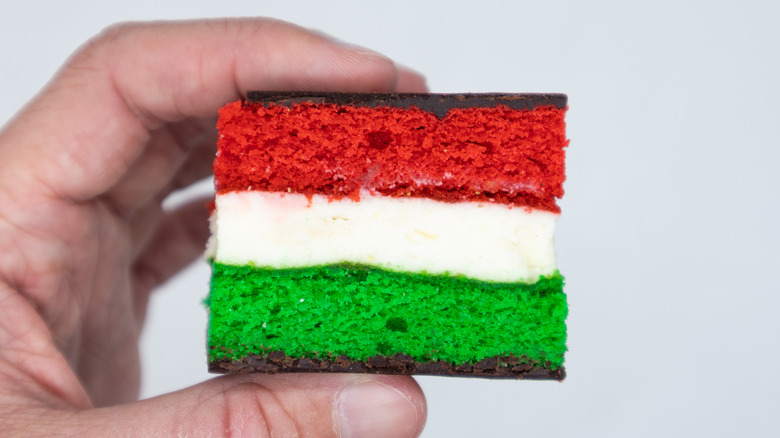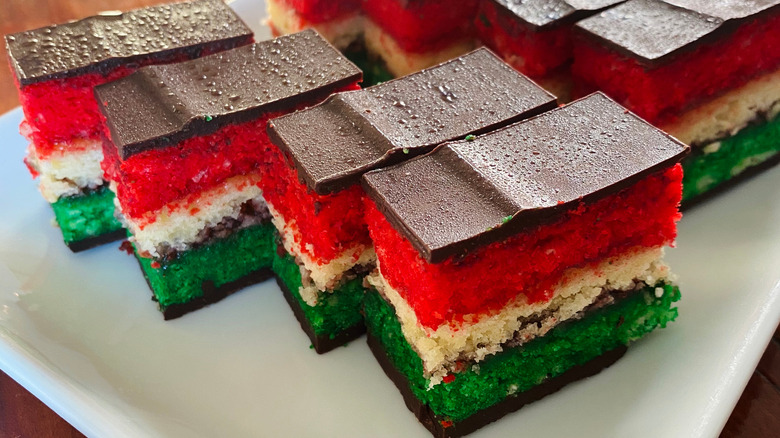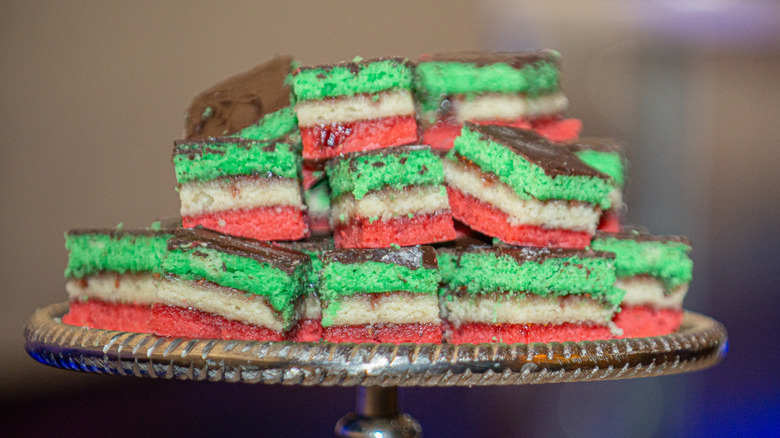The Immigrant Origins Of Classic Italian Rainbow Cookies
Nutty and crumbly, rainbow cookies certainly make a colorful statement on a dessert tray featuring three times the color. The traditional cookie is colored red, white, and green after the Italian flag. Given the homage, diners likely think that the dessert originated in Italy. However, rainbow cookies were actually created in America, although they were inspired by Italian heritage and traditions. "It's a very old school, Italian-American cookie, which has a homey, authentic appeal to so many people," Chef Amy Brandwein told Eater.
Although it's not known who first conjured up rainbow cookies, Italian immigrants created the cookies in the late 1800s and early 1900s. It quickly became a hit in Italian American bakeries in cities with a large Italian immigrant population like New York. Although the dish is not based on a counterpart in Italy, it does have Italian inspirations. The Italian nougat dish gelato di Campagna may have served as inspiration for the dessert. Similar to rainbow cookies, the dessert features an assortment of colors. However, gelato di Campagna is made with melted sugar and candied fruits. Meanwhile, rainbow cookies are made with almond paste and jams.
Likewise, there's an Italian dish Pasticcini arcobaleno, which is served around the holiday season. The pastries are similarly rainbow colored. Rainbow cookies exist in a ballpark of their own, making them unique.
Is it a cookie or a cake?
While they're known as rainbow cookies, the name is a bit of a misnomer. Rainbow cookies don't feature all the colors of the rainbow. Traditionally, they have just the three colors of the Italian flag. That has also earned them the nickname tri-color cookies, Italian Flag cookies, or Neapolitans. Some refer to them as Venetian cookies after the Italian city of Venice as well, despite the fact they're actually Sicilian in origin. Sicilian immigrants are believed to have invented the dessert in New York.
The dessert also goes by the name of a seven-layer cookie thanks to the way the ingredients are layered. Rainbow cookies feature three layers of cake, two layers of raspberry jam, and two layers of chocolate. "Each layer is made with almond paste, butter, eggs, sugar, and flower, and the layers are set with dark chocolate," Chef Amy Brandwein told Eater.
Despite its many names, rainbow cookies aren't actually cookies. They resemble a triple-layer cake. Each cake layer is made with sponge-like cake, making for a moist crumble. The denseness is caused by the almond paste used to make the cake. Typically, it's stored in the fridge to keep it cool. Over the years, rainbow cookies have spawned other variants.
Other versions of the cookie
While rainbow cookies have Italian origins, they have crossed over into other cultures as well. In particular, Jewish communities in New York City have adopted the dessert, putting their own spin on rainbow cookies. During the 1900s, Jewish immigrants moved to the city where they intermingled with Italians in the closely packed neighborhoods. The Jewish version of rainbow cookies swap out butter for margarine due to cultural practices. Jewish bakers swap the ingredients so the dessert can be served alongside meats. Dairy and meat are prohibited from intermingling according to Jewish kosher laws. Additionally, the Jewish version of rainbow cookies adds a chocolate layer to the bottom in addition to the top. Rainbow cookies are sometimes served at Passover, colored blue and white. As an everyday cookie, Jewish communities swap the colors of the cookie to blue, white, and yellow to represent their own community.
In recent years, rainbow cookies have also become popular among the LGBTQ community as a pride representation. These cookies include more colors incorporating orange, blue, purple, and yellow in addition to red and green. Canteen on Commercial Street in Provincetown, Massachusetts serves the LGBTQ-inspired cookies. Co-owner Rob Anderson explained to the LA Times, "For us at the Canteen, being a queer-owned restaurant in a very LGBTQ-centric town, it made sense for us to use the foundation of a traditional cookie and expand it to resemble the full-blown rainbow."


